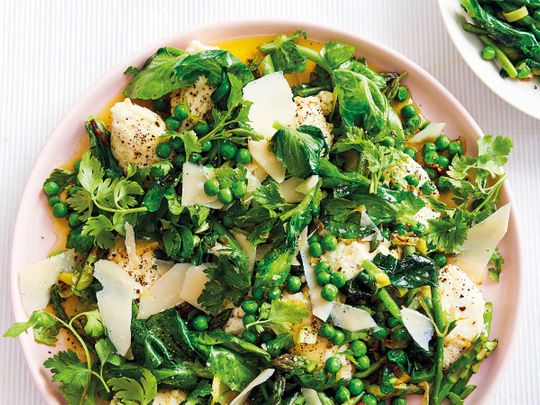
There are things I appreciate eating in a restaurant because they will always be better than if I try to do it myself.
Fresh pasta is at the top of that list.
Sure, it’s doable in one’s own kitchen — just maybe not my kitchen, since I am not blessed with the kind of free time (or patience) that would allow for such a practice.
But dumplings? I’ll make dumplings all day long, particularly the plump, unfilled, doughy variety.
These gnocchi-like pillows of joy have a pleasingly short ingredient list: ricotta, flour and eggs, and unlike fresh pasta, require almost zero technical skill, time or special equipment.
They are a different beast from fresh fettuccine, but I still think of them as a way to fulfil the desire I have to make pasta without having to, you know, actually make pasta.
There are many good things about these cheesy, salty dumplings, like how the dough comes together in minutes and needs only a spoon to shape, and how I won’t even ask you to drain the ricotta before making them.
But their best trait may be how they are the ideal vehicle for spring produce, words we have waited an eternity to hear.
While the dumplings boil in heavily salted water, use that time to briefly cook any assortment of very green, very springy things in melted butter and olive oil until they turn even greener and almost tender.
I always start with some sort of allium, like leeks, spring onions or scallions, then add a mix of ingredients like asparagus cut into bite-size pieces, shelled fava beans and peas in every form imaginable (snap, sugar, snow, shoots, leaves).
Know that regardless of what the recipe says, this is a great opportunity to go all out with those niche, short-seasoned spring items (ramps, green garlic) that pop up and might get you wondering, “What should I do with these?”
This is what you should do with them.
Once the dumplings have puffed and cooked through (pluck one from the water and cut it in half to test for doneness; it should be light and fluffy rather than dense and doughy), they are added to the skillet and gently tossed to coat in that buttery business so they can mingle with all the vegetables.
From there, transfer the dumplings to a large serving bowl or plate.
Then absolutely shower them in fresh herbs (parsley and mint are complementary without being overbearing) and sweet, grassy pea tendrils if you can get your hands on them. (They are always worth getting your hands on.)
For those worried that their dumplings may not be perfectly spherical or uniform, take pleasure in knowing that part of their charm lies in their rustic, clunky imperfection. Besides, with all those spring vegetables in the bowl, nobody’s looking at them anyway.
Ricotta Dumplings With Buttered Peas and Asparagus
Recipe
Yield: 4 servings
Total time: 30 minutes
Ingredients
- 2 cups whole-milk ricotta
- 2 large eggs
- Kosher salt and black pepper
- 3/4 cup all-purpose flour
- 4 tablespoons unsalted butter
- 2 tablespoons olive oil, plus more for serving
- 1 large leek, white and light green parts only, thinly sliced
- 1 bunch asparagus, woody ends removed, cut into 2-inch pieces
- 2 cups shelled fresh or frozen peas
- 3 cups pea shoots or leaves, thick stems removed
- 1/4 cup parsley or mint leaves, for serving
- Parmesan or pecorino, for serving
Method
- Bring a large pot of salted water to a boil.
- Combine ricotta and eggs in a large bowl. Season with salt and pepper and, using a large wooden or metal spoon, gently mix in the flour, taking care not to overmix (which could result in tough dumplings).
- Meanwhile, heat butter and 2 tablespoons olive oil in a large skillet over medium-high. Add leeks and season with salt and pepper. Cook, stirring occasionally, until leeks have softened completely and are starting to pick up some colour, 5 to 8 minutes.
- Add asparagus and peas to the skillet and season with salt and pepper. Cook, tossing occasionally, until asparagus is just tender and bright green, 2 to 4 minutes, depending on its thickness. Remove from heat while you cook the dumplings.
- When the water is at a nice steady boil, drop the ricotta mixture into the pot by the heaping spoonful. (The dumplings will expand in the water, so make them slightly smaller than you’d like them to end up.) Be careful not to crowd the pot; cook the dumplings in batches if need be.
- Once the dumplings rise to the top, let them boil until cooked through, 4 to 5 minutes. (You can always pull one out and cut it in half to test its doneness; the texture will go from dense and doughy to light and pillowy.)
- As the dumplings finish cooking, use a slotted spoon to transfer them to the skillet with the peas and asparagus. Once they’re all in there, give everything a quick toss over medium heat just to evenly coat the dumplings in the buttery sauce. Add pea shoots and toss just to wilt slightly.
- Transfer to a large serving bowl or platter and top with parsley, cheese and more olive oil, if you like.












